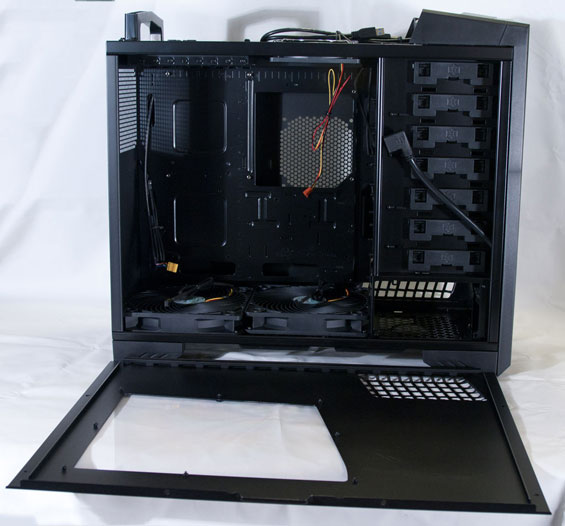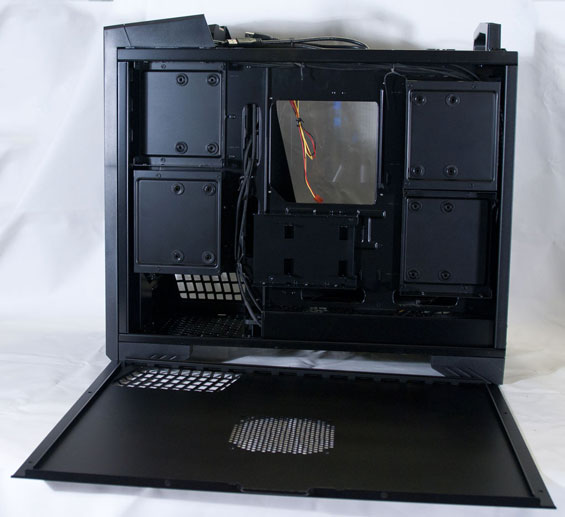SilverStone Raven RV03: Streamlined Bird of Prey
by Dustin Sklavos on July 20, 2011 1:00 AM EST- Posted in
- Cases/Cooling/PSUs
- SilverStone
- Full-Tower
In and Around the SilverStone Raven RV03
I may be a glutton for punishment at this point, but for me, half the fun of a SilverStone enclosure is figuring out how it comes together. There's always a logic to it, but SilverStone's designs often deviate wildly from the norm and so assembly is oftentimes just as unusual. Before getting into that, though, it's worth addressing the RV03's exterior and unfortunately I think they've taken a step back with this model.
The gold strips that run up the front and across the top are removable, and that's good because they're an accent that cheapens the look of the RV03. Taken on its own this iteration's face is a little more subdued than most gaming enclosures, but compared to the RV02 it's gaudy. The RV02's 5.25" bay covers didn't have the same V-shaped accents the RV03's have (or the colored trim for that matter), and the top of the enclosure was sleeker.
There's a little bit of schizophrenia in the placement of the fan controls and USB 3.0 ports as well; the USB 3.0 ports and audio jacks are covered by a door while the fan controls are entrenched in a metal plate in the open gap between the door and snap-on cover that shields the expansion slots and I/O cluster. I can't help but feel like all of these should've been hidden under the door.

When you do pop the RV03 open, you'll find an interior that seems a lot busier than its predecessor (not to mention most other cases), and that's due to the modularity of the design. SilverStone is pretty big on customization with their enclosures and the RV03 is a doozy that way. Cable routing should be fairly simple given the spacious motherboard tray and routing holes surrounding it, and SilverStone included two drive bay adapters for the copious 5.25" bays in front (seven in all) that allow you to trade three 5.25" bays for three 3.25" bays and additional 120mm fan mounts.
Beneath the column of 5.25" bays is the power supply mount with a cable that routes in from the plug on the bottom of the case. Users of larger PSUs beware: this bay supports 180mm of depth max. There are grilles on both side panels around this bay to improve airflow and cable clearance, but this bay is really designed for PSUs with bottom intakes.
Next to the motherboard tray at the "rear" of the case is yet another 120mm fan mount that, if used, will block off the eighth expansion slot. Finally, there's a 120mm exhaust fan at the top of the case, where one would usually be in relation to a motherboard. Well, not finally, we're not quite done yet.

Pop over to the other side and you'll see not only the opening in the motherboard tray for aftermarket cooling ([insert generic jab at Intel's HSF mounting mechanism here]), but four 3.5" drive mounts and a fifth mount able to hold a pair of 2.5" drives. That fifth mount is expressly for SSDs, as odds are good two stacked mechanical drives would overheat if used there. Keeping the drives behind the motherboard tray is an interesting choice since it helps minimize cabling around the motherboard itself, but there's virtually no ventilation back here. SilverStone includes a 120mm fan mount in the side panel that will blow directly onto the back of the processor socket and hopefully spill some of that air to the surrounding drives, but I'd be concerned about heat nonetheless. Mechanical hard drives are specced to tolerate between 50C and 60C maximum, but remember they're mechanical: do you really want to push it?
















25 Comments
View All Comments
Dustin Sklavos - Wednesday, July 20, 2011 - link
In terms of physical space, we do at least tell you how much stuff you can theoretically cram into the enclosure. Beyond that I think you're being unreasonable.Getting the hardware to do the kind of testing you're asking for isn't impossible, but it's not really practical either. Having done enough of these tests at this point, I already feel like our overclocked rig is pushing it in terms of just noise.
Also, understand that while multi-GPU subsystems aren't as uncommon as they used to be, they're still far from being the norm, and a good single GPU system is often still going to be preferable to a dual or multi-GPU configuration. The soundcard and PCIe SSD you're suggesting aren't actually going to really change test results either, they may increase the case's ambient temperature by a degree or two at most.
And then, let's say we move over to a dual-GPU configuration. Which cards? Do we use a board with ample spacing between the two PCIe x16 slots or sandwich the cards together to see if the case can handle that kind of load? Do we use cards with blower-style coolers or coolers that exhaust heat back into the case?
Honestly I think you're selling the testing short. Off the top of my head, just from looking at documentation, I'd've thought the Raven would've murdered the competition, but instead its lead is nowhere near as comfortable as I expected and hoped.
Ananke - Wednesday, July 20, 2011 - link
This is one ugly piece of cheap looking plastic. $19 including all fans shall be the maximum paid, before discounts.Totally - Friday, July 22, 2011 - link
Isn't the Raven a scavenger and not a bird of prey?The0ne - Monday, July 25, 2011 - link
They are both. I hate them so much.AEternal1 - Tuesday, July 26, 2011 - link
I've always made my own case contraptions for my computers, because i run insane configurations, and ive yet to find a case that can keep up to my expectations. this is the first case ive bought that i still use.I run my I5 2500K @ 4.8 and my gtx 560 TI @ 1ghz. needless to say, heat is always very hard for me to dissipate in a case, especially since I prefer big air over big water.
I've got nearly every fan option running in this case, I spent about 120$ for extra fans to fit, since most of my extra fans were smaller.
I mounted all 4 of my mechanical hard drives in the back tray, and with this case's thermal design, they all run cooler than they ever did in my open air cases that ive built.
my cpu runs at 40* to 55* with a noctua nh d-14. with the thermal layout i was able to implement with all the fan layouts i had available to me, i can actually put my hands in the case, and one hand will feel cool air, and the other will feel the warm air. thats pretty awesome. i have my cpu air being pushed onto the backs of my graphics card to help cool the backside of them, as opposed to venting the cpu straight up and out. with this cases bottom fans, and then the added fans, it takes all the heat from this area and diverts it perfectly. my graphics cards finally run cooler than in an open air solution, and my cpu stays just as cool as always.
the end result is that this is the first case to actually out perform an open air solution.